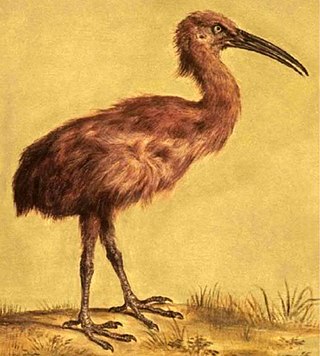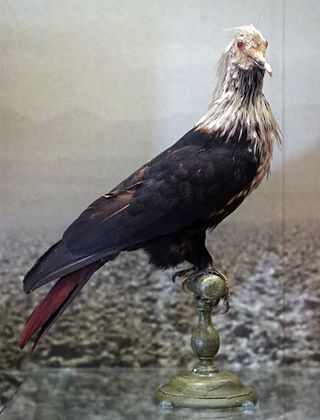
The genus Nestor is one of the two extant genera of the parrot family Strigopidae. Together with the kākāpō, and the extinct parrots in the genus Nelepsittacus, they form the parrot superfamily Strigopoidea. The Nestor's genus contains two extant parrot species from New Zealand and two extinct species from Norfolk Island, Australia and Chatham Island, New Zealand, respectively. All species are large stocky birds with short squarish tails. A defining characteristic of the genus is the tongue, which is tipped with a hair-like fringe. The superficial resemblance of this tongue to that of lorikeets has led some taxonomists to consider the two groups closely related, but DNA evidence shows they are not.

The white swamphen, also known as the Lord Howe swamphen, Lord Howe gallinule or white gallinule, is an extinct species of rail which lived on Lord Howe Island, east of Australia. It was first encountered when the crews of British ships visited the island between 1788 and 1790, and all contemporary accounts and illustrations were produced during this time. Today, two skins exist: the holotype in the Natural History Museum of Vienna, and another in Liverpool's World Museum. Although historical confusion has existed about the provenance of the specimens and the classification and anatomy of the bird, it is now thought to have been a distinct species endemic to Lord Howe Island and most similar to the Australasian swamphen. Subfossil bones have also been discovered since.
George Raper was a Royal Navy officer who as an able seaman joined the crew of HMS Sirius and the First Fleet to establish a colony at Botany Bay, New South Wales, now Australia. He is best known today for his watercolour sketches of the voyage and settlement, particularly birds and flowers of Sydney Cove.

The broad-billed parrot or raven parrot is a large extinct parrot in the family Psittaculidae. It was endemic to the Mascarene island of Mauritius. The species was first referred to as the "Indian raven" in Dutch ships' journals from 1598 onwards. Only a few brief contemporary descriptions and three depictions are known. It was first scientifically described from a subfossil mandible in 1866, but this was not linked to the old accounts until the rediscovery of a detailed 1601 sketch that matched both the subfossils and the accounts. It is unclear what other species it was most closely related to, but it has been classified as a member of the tribe Psittaculini, along with other Mascarene parrots. It had similarities with the Rodrigues parrot, and may have been closely related.

The Norfolk kākā is an extinct species of large parrot, belonging to the parrot family Nestoridae. The birds were about 38 cm long, with mostly olive-brown upperparts, reddish-orange cheeks and throat, straw-coloured breast, thighs, rump and lower abdomen dark orange and a prominent beak. It inhabited the rocks and treetops of Norfolk Island and adjacent Phillip Island. It was a relative of the New Zealand kākā.

The red rail is an extinct species of rail that was endemic to the Mascarene island of Mauritius, east of Madagascar in the Indian Ocean. It had a close relative on Rodrigues island, the likewise extinct Rodrigues rail, with which it is sometimes considered congeneric, but their relationship with other rails is unclear. Rails often evolve flightlessness when adapting to isolated islands, free of mammalian predators, and that was also the case for this species. The red rail was a little larger than a chicken and had reddish, hairlike plumage, with dark legs and a long, curved beak. The wings were small, and its legs were slender for a bird of its size. It was similar to the Rodrigues rail, but was larger, and had proportionally shorter wings. It has been compared to a kiwi or a limpkin in appearance and behaviour.

The Mauritius blue pigeon is an extinct species of blue pigeon formerly endemic to the Mascarene island of Mauritius in the Indian Ocean east of Madagascar. It has two extinct relatives from the Mascarenes and three extant ones from other islands. It is the type species of the genus of blue pigeons, Alectroenas. It had white hackles around the head, neck and breast and blue plumage on the body, and it was red on the tail and the bare parts of the head. These colours were thought similar to those of the Dutch flag, a resemblance reflected in its French common name, Pigeon Hollandais. The juveniles may have been partially green. It was 30 cm (12 in) long and larger and more robust than any other blue pigeon species. It fed on fruits, nuts, and molluscs, and was once widespread in the forests of Mauritius.

Hawkins's rail, also called the giant Chatham Island rail or in Moriori as mehonui, is an extinct species of flightless rail. It was endemic to the Chatham Islands east of New Zealand. It is known to have existed only on the main islands of Chatham Island and Pitt Island. Hawkins's rail was the largest terrestrial bird native to the Chatham Islands, around 40 centimetres (16 in) tall and weighing about 2 kilograms (4.4 lb). It had a long, downward curving beak. Historic accounts likely referring to the bird by the name "mehonui" suggest that it was red-brown in colour, and it has been compared to the weka in ecological habits, using its beak to probe decaying wood for invertebrates. Hawkins's rail likely became extinct due to overhunting by the islands native inhabitants, the Moriori, and the bird is known from skeletal remains found in their kitchen middens.

The buff-banded rail is a distinctively coloured, highly dispersive, medium-sized rail of the rail family, Rallidae. This species comprises several subspecies found throughout much of Australasia and the south-west Pacific region, including the Philippines, New Guinea, Australia, New Zealand, and numerous smaller islands, covering a range of latitudes from the tropics to the subantarctic.

The New Zealand quail, or koreke in Māori, is an extinct quail species endemic to New Zealand. The male and female were similar, except the female was lighter. The first scientist to describe it was Sir Joseph Banks when he visited New Zealand on James Cook's first voyage. Terrestrial and temperate, this species inhabited lowland tussock grassland and open fernlands. The first specimen to be obtained by a European was collected in 1827 by Jean René Constant Quoy and Joseph Paul Gaimard on Dumont D'Urville's voyage. It most likely went extinct due to diseases from introduced game birds.
The Tasman starling was described in 1836 by John Gould as a species which occurred on both Norfolk Island and Lord Howe Island. In 1928 Australian ornithologist Gregory Mathews recognized that the plumage of the race from Lord Howe Island was much browner and more greyish than the plumage of the Norfolk Island race and split the species into two forms, the Norfolk starling, and the Lord Howe starling. Both subspecies are now extinct, thus so the species.

The tomtit is a small passerine bird in the family Petroicidae, the Australasian robins. It is endemic to the islands of New Zealand, ranging across the main islands as well as several of the outlying islands. In the Māori language, the North Island tomtit is known as miromiro and the South Island tomtit is known as ngirungiru. This bird has several other Māori and English names as well. There are several subspecies showing considerable variation in plumage and size. The species is not threatened and has adapted to the changes made to New Zealand's biodiversity.

The austral snipes, also known as the New Zealand snipes or tutukiwi, are a genus, Coenocorypha, of tiny birds in the sandpiper family, which are now only found on New Zealand's outlying islands. There are currently three living species and six known extinct species, with the Subantarctic snipe having three subspecies, including the Campbell Island snipe discovered as recently as 1997. The genus was once distributed from Fiji, New Caledonia and Norfolk Island, across New Zealand and southwards into New Zealand's subantarctic islands, but predation by introduced species, especially rats, has drastically reduced their range.

The spotted green pigeon or Liverpool pigeon is a species of pigeon which is most likely extinct. It was first mentioned and described in 1783 by John Latham, who had seen two specimens of unknown provenance and a drawing depicting the bird. The taxonomic relationships of the bird were long obscure, and early writers suggested many different possibilities, though the idea that it was related to the Nicobar pigeon prevailed, and it was therefore placed in the same genus, Caloenas. Today, the species is only known from a specimen kept in World Museum, Liverpool. Overlooked for much of the 20th century, it was recognised as a valid extinct species by the IUCN Red List only in 2008. It may have been native to an island somewhere in the South Pacific Ocean or the Indian Ocean, and it has been suggested that a bird referred to as titi by Tahitian islanders was this bird. In 2014, a genetic study confirmed it as a distinct species related to the Nicobar pigeon, and showed that the two were the closest relatives of the extinct dodo and Rodrigues solitaire.

The Norfolk pigeon or Norfolk Island pigeon, sometimes called the wood quest, is an extinct subspecies of the New Zealand pigeon (kererū) that inhabited Norfolk Island. This population probably colonised Norfolk Island from New Zealand during the Pleistocene. It became extinct around the turn of the 20th century.

The Chatham kākā or Chatham Island kākā is an extinct parrot species previously found on the Chatham Islands, New Zealand. The first individuals were thought to belong to the New Zealand kākā, but detailed examination of the subfossil bones showed that they actually belong to a separate endemic species. The species became extinct within the first 150 years of the arrival of the Polynesians around 1500, long before any European settlers. No skins or descriptions are available.

The Lord Howe parakeet, also known as the Lord Howe red-fronted parakeet, is an extinct parrot endemic to Lord Howe Island in the Tasman Sea, part of New South Wales, Australia. It was described as full species by Tommaso Salvadori in 1891, but subsequently it has been regarded as subspecies of the red-crowned parakeet. In 2012, the IOC World Bird List recognised it as species.
The Vava'u rail is an extinct species of bird in Rallidae. It was first described in 1793 from an illustration. In 2020 subfossil remains were found on the island of Vuna, in the Vava'u island group of Tonga.
















